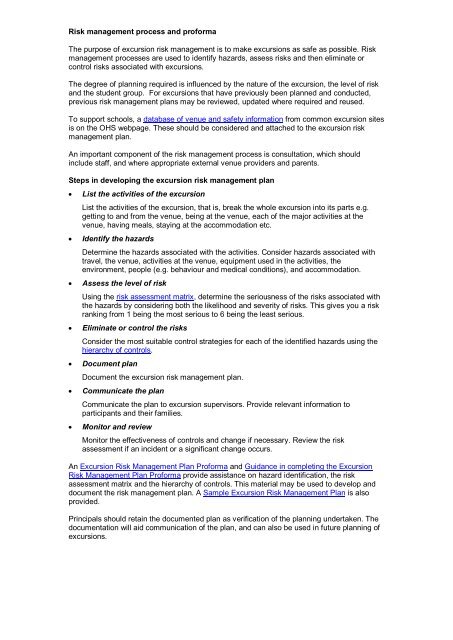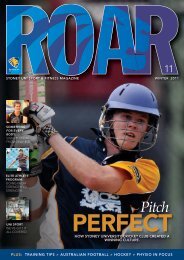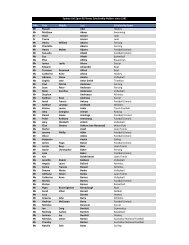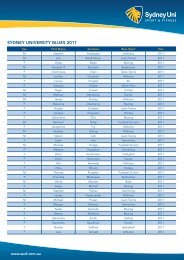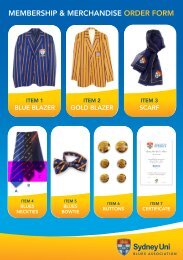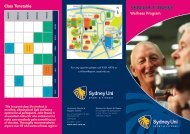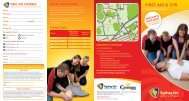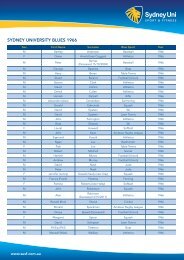Risk Assessment Form: Module 1 - Sydney Uni Sport & Fitness
Risk Assessment Form: Module 1 - Sydney Uni Sport & Fitness
Risk Assessment Form: Module 1 - Sydney Uni Sport & Fitness
You also want an ePaper? Increase the reach of your titles
YUMPU automatically turns print PDFs into web optimized ePapers that Google loves.
<strong>Risk</strong> management process and proforma<br />
The purpose of excursion risk management is to make excursions as safe as possible. <strong>Risk</strong><br />
management processes are used to identify hazards, assess risks and then eliminate or<br />
control risks associated with excursions.<br />
The degree of planning required is influenced by the nature of the excursion, the level of risk<br />
and the student group. For excursions that have previously been planned and conducted,<br />
previous risk management plans may be reviewed, updated where required and reused.<br />
To support schools, a database of venue and safety information from common excursion sites<br />
is on the OHS webpage. These should be considered and attached to the excursion risk<br />
management plan.<br />
An important component of the risk management process is consultation, which should<br />
include staff, and where appropriate external venue providers and parents.<br />
Steps in developing the excursion risk management plan<br />
<br />
<br />
<br />
<br />
<br />
<br />
<br />
List the activities of the excursion<br />
List the activities of the excursion, that is, break the whole excursion into its parts e.g.<br />
getting to and from the venue, being at the venue, each of the major activities at the<br />
venue, having meals, staying at the accommodation etc.<br />
Identify the hazards<br />
Determine the hazards associated with the activities. Consider hazards associated with<br />
travel, the venue, activities at the venue, equipment used in the activities, the<br />
environment, people (e.g. behaviour and medical conditions), and accommodation.<br />
Assess the level of risk<br />
Using the risk assessment matrix, determine the seriousness of the risks associated with<br />
the hazards by considering both the likelihood and severity of risks. This gives you a risk<br />
ranking from 1 being the most serious to 6 being the least serious.<br />
Eliminate or control the risks<br />
Consider the most suitable control strategies for each of the identified hazards using the<br />
hierarchy of controls.<br />
Document plan<br />
Document the excursion risk management plan.<br />
Communicate the plan<br />
Communicate the plan to excursion supervisors. Provide relevant information to<br />
participants and their families.<br />
Monitor and review<br />
Monitor the effectiveness of controls and change if necessary. Review the risk<br />
assessment if an incident or a significant change occurs.<br />
An Excursion <strong>Risk</strong> Management Plan Proforma and Guidance in completing the Excursion<br />
<strong>Risk</strong> Management Plan Proforma provide assistance on hazard identification, the risk<br />
assessment matrix and the hierarchy of controls. This material may be used to develop and<br />
document the risk management plan. A Sample Excursion <strong>Risk</strong> Management Plan is also<br />
provided.<br />
Principals should retain the documented plan as verification of the planning undertaken. The<br />
documentation will aid communication of the plan, and can also be used in future planning of<br />
excursions.
Checklist<br />
Step 1<br />
Step 2<br />
Is a previous risk assessment for the excursion available If so, review and<br />
update with reference to this checklist, considering such issues as changes to<br />
the student group, individual student health care plans, the effectiveness of<br />
the controls and previous incidents on previous excursion.<br />
Obtain venue information<br />
To assist in planning excursions, information is available on the OHS<br />
webpage for frequently used venues.<br />
If no venue and safety information is available on the database, contact the<br />
venue. Depending on the nature of the excursion and the proposed activities,<br />
enquire about:<br />
o<br />
o<br />
o<br />
o<br />
o<br />
o<br />
o<br />
o<br />
o<br />
o<br />
o<br />
Public liability cover<br />
Accreditation of venue staff for the task/activity<br />
Access and special requirements e.g. for students with special needs<br />
If venue located in vicinity of <strong>Sydney</strong> or major CBD, be aware of possible<br />
evacuation trials or plans (NSW State Emergency Management<br />
Committee: www.emergency.nsw.gov.au )<br />
Emergency procedures and relevant training of venue staff<br />
Known hazards and controls related to proposed activities<br />
Where a student with a severe food allergy is attending an excursion<br />
venue where food is provided, contact the venue to enquire about their<br />
procedures to cater for severe food allergies. Explain the nature of the<br />
student’s anaphylactic condition, the foods that trigger anaphylaxis and<br />
the serious consequences for the student coming into contact with that<br />
food. Consultation with parents/carers is essential in this process.<br />
Mobile phone and emergency services access for the excursion<br />
Equipment available; ask venue to confirm that equipment and<br />
machinery are maintained, repaired and in good working order with<br />
safety features operational<br />
Use of licensed personnel for construction, maintenance and repairs<br />
Availability of appropriate facilities e.g. showers, refreshments, toilets.<br />
Step 3<br />
Step 4<br />
Step 5<br />
Assess venue and safety information for your student group. Note this on the<br />
proforma and attach the venue and safety information to your risk<br />
management plan.<br />
In consultation with key stakeholders, analyse the excursion and list the<br />
activities, that is, break the excursion into its parts e.g. getting to and from the<br />
venue, being at the venue, each of the major activities at the venue, having<br />
meals, staying at the accommodation etc.<br />
Identify the hazards associated with the activities and the potential risks<br />
associated with these hazards. Take account of venue and safety<br />
information, the student group, individual student health care plans and<br />
previous incidents on excursions. See Guidance in completing the Excursion<br />
<strong>Risk</strong> Management Plan Proforma for categories of hazards and the Sample<br />
Excursion <strong>Risk</strong> Management Plan for examples.<br />
Important note about Step 5<br />
If a student has been diagnosed with anaphylaxis, the individual health care plan must be<br />
updated to address the student’s needs on excursions following completion of the Excursion<br />
<strong>Risk</strong> Management Plan. Excursions may pose different hazards to the school environment<br />
and the health care plan must be updated accordingly. Anaphylaxis is a potentially life<br />
threatening condition. It is a severe and sudden reaction and occurs when a person is<br />
exposed to an allergen (such as a food or insect bite). Reactions usually begin within minutes<br />
of exposure and can progress rapidly over a period of up to two hours or more.
Step 6<br />
Step 7<br />
Step 8<br />
Step 9<br />
Assess the risks associated with the hazards using the risk assessment<br />
matrix in the Guidance in completing the Excursion <strong>Risk</strong> Management Plan<br />
Proforma. This gives a risk ranking and thus a priority order for managing the<br />
hazards.<br />
Develop appropriate strategies to eliminate or control the risks (including<br />
action to ensure that child protection procedures are followed, health care<br />
plans are updated for students, and that all necessary aides and equipment<br />
are available) using the hierarchy of controls on the Guidance in completing<br />
the Excursion <strong>Risk</strong> Management Plan Proforma.<br />
Document the risk management plan including emergency management<br />
procedures to deal with potential incidents. The attached proforma may be<br />
used. See also the Sample Excursion <strong>Risk</strong> Management Plan for examples.<br />
Communicate the plan to excursion supervisors including responsibilities for<br />
emergency response. Provide relevant information to participants and their<br />
families.<br />
Step 10 Review the excursion risk management plan on completion.
Guidance in Completing the <strong>Risk</strong> Management Plan Proforma: Excursion<br />
Hazard Identification<br />
The following may assist with identifying hazards relating to activities at each stage of an excursion. Consider what<br />
could go wrong, that is, the potential injuries or illnesses that could occur. Hazards are the sources of these potential<br />
injuries or illnesses.<br />
Travel – Consider aspects of travel that may present a hazard<br />
such as walking to and from the train, crossing the road,<br />
transport to the venue. If CBD location, consider travel<br />
arrangements in the event of lockdown or evacuation.<br />
Venue – Consider aspects of the excursion venue that may<br />
present a hazard such as location near water, cliffs, crowds,<br />
slippery floors. If CBD location, consider possibility of CBD<br />
lockdown or evacuation due to evacuation trial or major<br />
emergency<br />
Excursion Program Activity – Consider the activities of the<br />
excursion program that may present a hazard such as hazards<br />
of bushwalking, collecting leaves, observing animals,<br />
swimming, singing at an eisteddfod, climbing, eating at different<br />
venues for students with anaphylaxis.<br />
Equipment – Consider any equipment that may present a<br />
hazard such as sporting equipment, high risk equipment at the<br />
venue.<br />
Environment – Consider aspects of the environment that may<br />
present a hazard such as weather conditions, natural hazards<br />
such as bushfires, floods or storms, the nature of the terrain,<br />
plants, animals and insects.<br />
Consider common allergens that may pose a hazard e.g. foods,<br />
insect stings or bites, latex (e.g. balloons or swimming goggles<br />
and caps) that may trigger allergic reactions. These must be<br />
considered as part of the risk assessment for students with<br />
allergic conditions (anaphylaxis).<br />
<strong>Risk</strong> <strong>Assessment</strong> Matrix<br />
How serious<br />
could the injury<br />
be<br />
How likely is it to be that<br />
serious<br />
Very<br />
Likely Likely Unlikely<br />
Death or<br />
permanent injury 1 1 2 3<br />
Long term<br />
illness or injury<br />
1 2 3 4<br />
Medical<br />
attention &<br />
several days off<br />
2 3 4 5<br />
First aid<br />
needed<br />
3 4 5 6<br />
Severity – is how<br />
seriously a person<br />
could be harmed<br />
Very<br />
Unlikely<br />
Likelihood – is an<br />
estimate of how probable it<br />
is for the hazard to cause<br />
harm.<br />
Legend<br />
1 and 2 Extreme risk; deal with the hazard<br />
immediately<br />
3 and 4 Moderate risk; deal with the hazard as<br />
soon possible<br />
5 and 6 Low risk; deal with the hazard when able.<br />
People – Consider aspects of people that may present a hazard such as poor behaviour, the nature of participants such<br />
as maturity, age and skill, child protection issues, medical conditions or disabilities.<br />
Accommodation – Consider aspects of accommodation that may present a hazard such as insufficient supervision,<br />
standard of accommodation and amenities, meal menus and allergies, security and child protection issues<br />
Other – Consider other hazards related to specific excursions such as access to first aid and mobile phone reception.<br />
Investigate access to emergency services and equipment.<br />
<strong>Risk</strong> Elimination or Control<br />
Eliminate the risk. Eliminate the item or activity; e.g. do not undertake a particular high risk activity such as abseiling in<br />
high wind; do not use high risk equipment. If elimination is not reasonably practicable, control the risk as far as practical<br />
using the hierarchy of controls below. Select the highest possible control and/or use a combination of controls to reduce the<br />
risk.<br />
Substitute the hazard: Replace the activity, material, or equipment with a less hazardous one eg choose an easier<br />
bushwalk; substitute a food known to cause severe allergic reactions (for example, peanut butter or tree nuts) with<br />
alternative nutritious food.<br />
Isolate the hazard: Isolate the hazard from the person at risk; isolate through distance e.g. select a lunch location well<br />
away from the water; check if a coastal walk has fencing.<br />
Use engineering controls: Have access to equipment to counteract the hazard; consider hiring coaches with<br />
seatbelts and ensure these are worn if available; ensure that an appropriately trained person is with the student at all<br />
times and has immediate access to an Epipen in the event of an emergency.<br />
Use administrative controls: Establish procedures and safe practices e.g. supervision of students, clear rules,<br />
instruction in safe methods, training of staff, volunteers and students in the excursion activities or in the use of<br />
equipment and qualifications of instructors. Ensure health care plans are reviewed and updated for the excursion for<br />
students known to have severe allergic conditions. Discuss student health needs with caterers, in consultation with<br />
parents/carers.<br />
Use personal protective equipment: Use appropriately designed and properly fitted equipment such as safety<br />
goggles, hats and sunscreen and helmets, in conjunction with other control measures identified from above. Encourage<br />
students and staff to wear appropriate footwear and protective clothing at all times; students wear medic alert bracelet<br />
or necklace where required.
Excursion <strong>Risk</strong> Management Plan Proforma<br />
<strong>Module</strong>: 1<br />
Name of <strong>Module</strong>: <strong>Fitness</strong> for a healthy lifestyle<br />
Description and location of excursion: Arena <strong>Sport</strong>s Centre, Western Ave, <strong>Uni</strong>versity of <strong>Sydney</strong>, Camperdown Campus.<br />
Activity<br />
Hazard Identification<br />
Type/Cause<br />
<strong>Risk</strong><br />
<strong>Assessment</strong><br />
Elimination or Control Measures Who When<br />
VO2 Sub Max Test<br />
Over exert themselves<br />
in test<br />
Dizziness 6<br />
Vomiting 6<br />
<br />
<br />
<br />
<br />
Warn students of dangers<br />
Make sure students are warmed<br />
up<br />
Make sure students cool down<br />
Make students are well hydrated<br />
Education<br />
Instructor/<br />
Teacher<br />
Before/<br />
During &<br />
Post Testing<br />
<br />
<br />
Not warmed up<br />
properly<br />
Have previous<br />
injuries especially<br />
to knees and<br />
ankles<br />
Not fully hydrated<br />
<br />
<br />
Injure muscles<br />
Further aggravate<br />
injury<br />
Dizziness 6<br />
Vomiting 6<br />
Dehydration 6<br />
6<br />
6<br />
<br />
<br />
<br />
<br />
<br />
<br />
Check whether students have any<br />
pre existing injuries that may<br />
preclude them from the activity.<br />
Get students to warm up and cool<br />
down properly<br />
Don’t let students who have<br />
current injuries participate in test<br />
Make sure that students have<br />
water bottles with them<br />
Make sure students are hydrated<br />
well before test<br />
Make sure that students warm up<br />
and cool down properly.<br />
Education<br />
Instructor/<br />
Teacher<br />
Education<br />
Instructor/<br />
Teacher<br />
On arrival<br />
Before/<br />
During &<br />
Post Testing<br />
Dizziness 6<br />
Are in poor health/not<br />
fully rested/medical<br />
conditions that may be<br />
affected by test.<br />
Vomiting 6<br />
Don’t let students who are in poor<br />
health or have medical conditions that<br />
may be affected by test participate.<br />
Education<br />
Instructor/<br />
Teacher<br />
On arrival<br />
Dehydration 6<br />
Blood Pressure<br />
Test Inflate cuff above 180<br />
Restrict blood flow<br />
Beyond testing point<br />
6 Instruct students clearly by giving<br />
demonstration and monitoring them<br />
Education<br />
Instructor/<br />
Teacher
(Sphygmomanometer)<br />
Cause Dizziness 6<br />
during activity<br />
Before Test<br />
Expose Stethoscope to<br />
loud noises whilst in<br />
ears i.e. yelling and<br />
tapping<br />
Ear damage 5<br />
Instruct students clearly by giving<br />
demonstration and monitoring them<br />
during activity<br />
Education<br />
Instructor<br />
Before Test<br />
Sprained Ankle<br />
6 Make sure that testing area is on<br />
level & dry surface<br />
Uneven ground:<br />
Trip/Fall over<br />
Uneven landing 5<br />
<br />
Give clear instructions on<br />
technique<br />
Education<br />
Instructor/<br />
Teacher<br />
Before/<br />
During &<br />
Post Testing<br />
Vertical Jump Test<br />
Knee injury 6<br />
<br />
Make sure that there is nothing<br />
that can be tripped over or fallen<br />
onto<br />
Equipment is not set up<br />
properly<br />
All of the above<br />
Finger injury<br />
6 Set equipment up correctly<br />
6<br />
<br />
Give clear instructions on<br />
technique<br />
Education<br />
Instructor<br />
Before Test<br />
Flexibility Test<br />
Not warming up<br />
Strain hamstring/lower back<br />
muscles<br />
6<br />
<br />
<br />
Give clear instructions on<br />
technique<br />
Make sure that students warm up<br />
and cool down<br />
Education<br />
Instructor/<br />
Teacher<br />
Before/<br />
During &<br />
Post Testing<br />
Hand & Forearm<br />
Strength Test:<br />
Increased blood pressure 6<br />
Increased inter-cranial<br />
pressure 6<br />
Hand Dynamometer<br />
Shoulder Arm Push<br />
Dynamometer<br />
<br />
<br />
Not Breathing<br />
Incorrect technique<br />
Inter-abdominal pressure<br />
(dangerous for people with<br />
previous internal<br />
haemorrhaging)<br />
6<br />
Demonstrate and give clear<br />
instructions on technique<br />
Education<br />
Instructor/<br />
Teacher<br />
Before test<br />
Leg & Back<br />
Dynomometer<br />
Lower back injury<br />
5
SPRINT TEST<br />
<br />
Trip/Fall over<br />
Sprained Ankle 6<br />
<br />
<br />
Make sure that testing area is on<br />
level & dry surface<br />
Make sure that there is nothing<br />
that can be tripped over or fallen<br />
onto<br />
<br />
<br />
Not Warming up<br />
Have previous<br />
injuries<br />
especially to<br />
Hamstrings and<br />
calf muscles<br />
Injure muscles 6<br />
Further aggravate injury 6<br />
Strain hamstring or calf<br />
muscle<br />
6<br />
Give clear instructions on technique<br />
Make sure that students warm up and<br />
cool down<br />
Education<br />
Instructor/<br />
Teacher<br />
Before/<br />
During &<br />
Post Testing<br />
Dizziness<br />
6<br />
Are in poor health/ Not<br />
fully rested/ Medical<br />
conditions that may be<br />
affected by test<br />
Vomiting 6<br />
Dehydration 6<br />
Fainting 4<br />
Don’t let students who are in poor<br />
health or have medical conditions that<br />
may be affected by test participate<br />
Education<br />
Instructor/<br />
Teacher<br />
Before test<br />
Anaerobic<br />
Dizziness<br />
6<br />
<br />
Make sure students have water<br />
bottles with them<br />
Wingate Test<br />
Not fully hydrated<br />
Vomiting 6<br />
<br />
Make sure students have had<br />
water well before test<br />
Education<br />
Instructor/<br />
Teacher<br />
Before/<br />
During &<br />
Post Testing<br />
Have not had anything<br />
to eat within 2hours<br />
before completing the<br />
Test<br />
Dehydration 6<br />
Dizziness<br />
Vomiting 6<br />
Dehydration 6<br />
6<br />
<br />
<br />
<br />
<br />
Make sure students warm up and<br />
cool down properly<br />
Make sure students have water<br />
bottles with them<br />
Make sure students have had<br />
water well before test<br />
Make sure students warm up and<br />
cool down properly<br />
Education<br />
Instructor/<br />
Teacher<br />
Before/<br />
During &<br />
Post Testing<br />
Not warm up properly<br />
Injure muscles<br />
Further aggravate injury 6<br />
6 Get students to warm up<br />
<br />
Don’t let students who have<br />
current injuries participate in test<br />
Education<br />
Instructor/<br />
Teacher<br />
Before/<br />
During &<br />
Post Testing
Have previous injuries<br />
especially to knee’s &<br />
ankles.<br />
Injure muscles<br />
Further aggravate injury 5<br />
6<br />
<br />
<br />
Get students to warm up<br />
Don’t let students who have<br />
current injuries participate in test<br />
Before/<br />
During &<br />
Post Testing<br />
Vomiting<br />
6<br />
Over exert themselves<br />
in test<br />
Dizziness<br />
Fainting<br />
6<br />
4<br />
<br />
<br />
<br />
Make sure students are warmed<br />
up<br />
Make sure students cool down<br />
Make sure students are well<br />
hydrated<br />
Education<br />
Instructor/<br />
Teacher<br />
Before/<br />
During &<br />
Post Testing<br />
Venue and safety information reviewed and attached: Yes / No<br />
Plan prepared by: Kate Gould Position: Education Coordinator Date: 02.06.2010<br />
Prepared in consultation with:<br />
Communicated to:<br />
Monitor and Review - Monitor the effectiveness of controls and change if necessary. Review the risk assessment if an incident or a significant change occurs.


